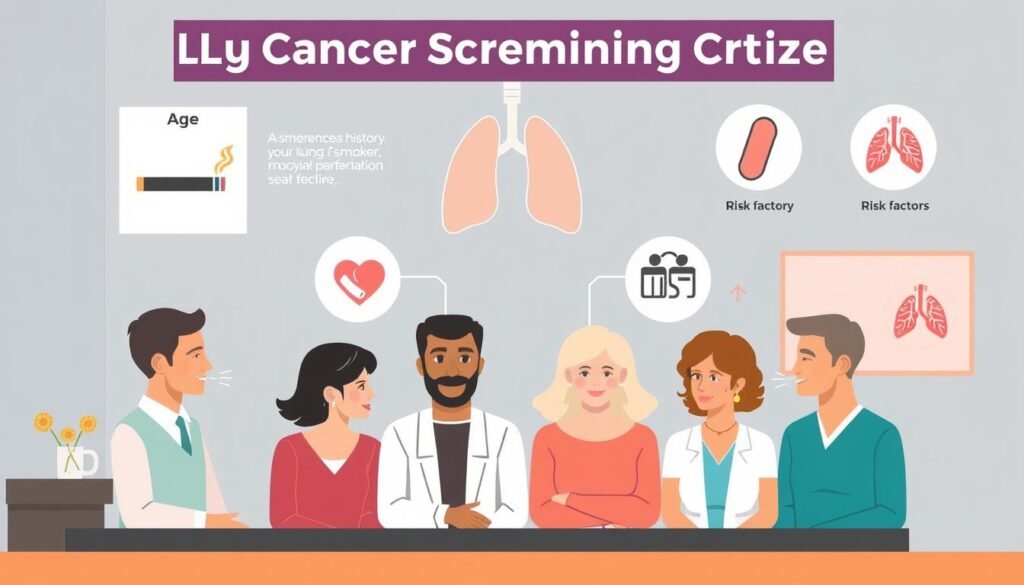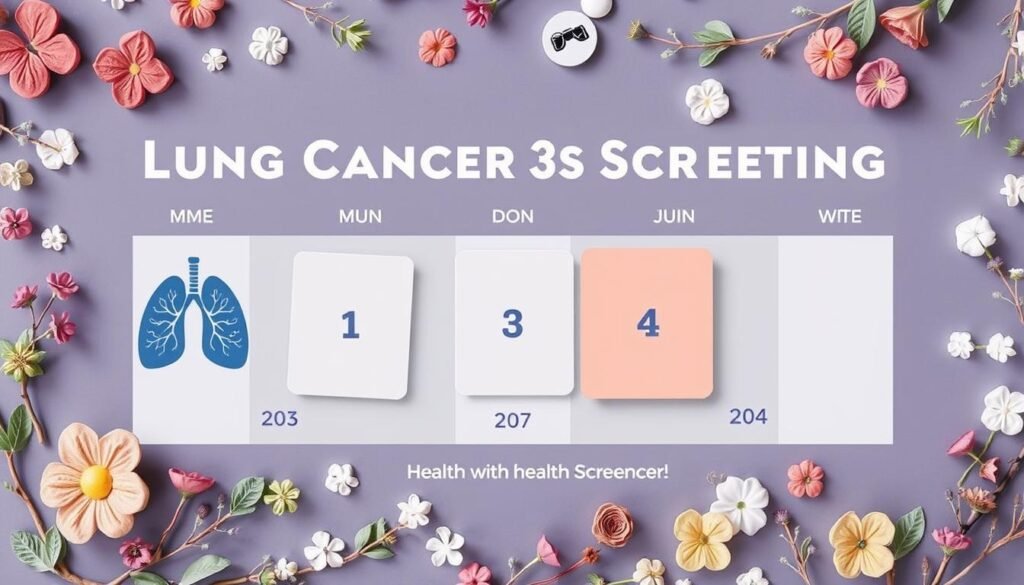Lung cancer leads to almost 25% of all cancer deaths in the US. It’s the top cause of cancer death, with 160,000 people dying each year. That’s more than the deaths from colon, breast, and prostate cancers combined. Early detection can greatly increase survival chances. The lung cancer screening guidelines by the USPSTF aim to find those at higher risk early on. This piece will explore the best practices for lung cancer screening. We’ll look at guidelines that help with early detection. This can lower the death rates from this terrible disease.
Key Takeaways
- Lung cancer is responsible for nearly 25% of cancer deaths in the U.S.
- Screening can significantly enhance survival rates through early detection.
- Guidelines recommend annual screenings for individuals aged 50-80 with a smoking history of at least 20 pack-years.
- Only 30% of lung cancer cases are detected early.
- Smoking is a primary risk factor for lung cancer-related deaths, with 80-90% linked to cigarette use.
- Individualized screening can optimize benefits and minimize risks.
- Smoking cessation strategies are crucial in preventative measures against lung cancer.
Understanding Lung Cancer
Lung cancer is one of the top cancers today. Roughly 228,820 people were diagnosed in the U.S. in 2020. It caused about 135,720 deaths in the same year. Knowing the main types, non-small cell (NSCLC) and small cell lung cancer (SCLC), is key.
Smoking is a major cause of lung cancer, linked to almost 90% of cases. Smokers are 20 times more likely to get lung cancer than non-smokers. If you have symptoms like a lasting cough or chest pain, see a doctor quickly. Most people are diagnosed at around age 70.
Race and gender affect lung cancer rates differently. African American men have a higher rate than white men. But African American women are less affected than white women. The five-year survival rate is only 20.5%, highlighting the need for early checks.
Knowing about risks like secondhand smoke and pollutants is crucial. The chance of getting lung cancer can depend on your race or gender. It’s vital to talk to doctors about screenings and catch it early. This can greatly help in managing the disease.
For detailed screening info, visit the American Cancer Society’s website. It’s important to know your personal risk factors.
Importance of Early Detection
Finding lung cancer early is key to better treatment results and higher lung cancer survival rates. Only 21% of lung cancers are found when they’re still just in one area, or stage I. This shows we need more awareness and screenings for lung cancer.
Finding cancer early greatly improves the chances of beating it. Those caught at the start have a 75% chance of living five more years. But, this drops to less than 10% for those found later. This shows how vital early detection is and why regular screenings are crucial.
The US Preventive Services Task Force says adults 50 to 80 years old should get checked every year. This is especially true for people who have smoked a lot over the years. Low-dose computed tomography (LDCT) scans are a good way to spot lung cancer early without surgery.
Studies, like the National Lung Screening Trial (NLST), show that regular screening lowers the death rate from lung cancer by 20%. This tells us that people at risk should get screened. Early detection means lung cancer can be treated more effectively.
| Stage of Detection | 5-Year Survival Rate |
|---|---|
| Localized (Stage I) | Exceeds 75% |
| Advanced (Stage IV) | Less than 10% |
Early detection plays a critical role. It gives people more and better treatment options, leading to a much better outlook. This makes regular checks and teaching patients about this very important.
Lung Cancer Screening Guidelines
Knowing about lung cancer test recommendations can save lives through early catch and treatment. The American College of Chest Physicians and others set screening guidelines for lung cancer. These are for people at high risk. They show that regular checks can lower deaths from lung cancer.
Recommended Age and Risk Factors
People 50 to 80 who smoked a lot should get checked every year. This comes from big studies like the National Lung Screening Trial. They found checks with a special X-ray can cut the death rate by 20% in these groups. Keep getting screened up to age 79 if the risk stays high.
Cigarette Smoking as a Primary Risk Factor
Cigarette smoking is the main cause of lung cancer, linked to 90% of cases in the US. Smokers’ risk is 20 times higher than for non-smokers. This fact highlights the need for talk about lung cancer test recommendations with doctors. It’s crucial for figuring out if screening is right and pushing for quitting smoking. Quitting lowers the risk as time goes on. For more on these guidelines, check out reputable sources.
Who Should Get Screened for Lung Cancer?
It’s key to know who should get checked for lung cancer early. The rules for who can get screened have changed. Now, more people can do these life-saving tests. We will look into who can get screened and why it’s essential to look at your smoking history.
Criteria for Screening Eligibility
To be screened for lung cancer, you must fit certain rules. These rules help find out if you’re at risk for lung cancer. You need to be:
- Age between 50 to 80 years.
- Currently smoking or you quit in the last 15 years.
- Have smoked a lot, like one pack per day for 20 years or the same amount in another way.
- Not diagnosed with lung cancer in the past 5 years.
These rules highlight the need to check on things like smoking and family history. This ensures that people who are more at risk can get screened in time.
Pack-Year History Explained
The pack-year formula is crucial for figuring out lung cancer risk. A pack-year is the number of cigarette packs smoked daily times the years smoked. If someone smokes two packs every day for 10 years, that’s 20 pack-years. Knowing this math is important for screening and understanding your risk for lung cancer.
Here’s a table showing different smoking habits and their pack-year scores:
| Smoking History | Daily Packs Smoked | Years Smoked | Pack-Year Calculation |
|---|---|---|---|
| 1 pack/day | 1 | 20 | 20 |
| 2 packs/day | 2 | 10 | 20 |
| 1/2 pack/day | 0.5 | 40 | 20 |
| 1 pack every other day | 0.5 | 40 | 10 |
Looking at pack-year history helps decide if someone can be screened. It also gives a better picture of lung cancer risk. This info helps doctors make the best plan for screening and preventing lung cancer.

Screening Methods for Lung Cancer
Lung cancer screenings are crucial for early detection. The top method today is Low-Dose Computed Tomography (LDCT). It helps find lung cancer early, which can save lives by improving treatment options.
Low-Dose Computed Tomography (LDCT)
LDCT is key for checking lung cancer. It uses less radiation than standard CT scans. This makes it better for those at high risk. Research shows LDCT reduces lung cancer deaths. The National Lung Screening Trial found LDCT is better than chest x-rays in finding cancer early. It’s especially good for heavy smokers, lowering their death risk from lung cancer.
Screening Efficacy and Benefits
Lung cancer screenings, like LDCT, are about finding serious problems early. This helps start treatment sooner. The American Cancer Society advises yearly LDCTs for those 50 to 80 who smoke or smoked a lot. This screening can catch lung cancer early and check for other lung issues.
Annual LDCT screenings can save lives of those at high risk. They improve chances of survival by allowing for quick treatment. But, people should talk to their doctors about the screenings’ benefits and risks, such as false positives and overdiagnosis. LDCT is a key tool in battling lung cancer, showing how well modern screenings work.
Screening Protocols and Intervals
Knowing when to get checked for lung cancer is key for people at high risk. The US Preventive Services Task Force (USPSTF) says adults 50 to 80 with a big smoking history need yearly checks. This change helps find lung cancer early in more people.
Annual vs. Biennial Screening
Checking for lung cancer every year is better than every two years. Yearly checks catch cancer sooner, which helps patients a lot. Doing this every year makes sure nothing is missed and can save lives. Studies show it also lets people live longer.
Importance of Consistency in Screening
Regular lung cancer checks are super important. Sticking to yearly checks means doctors can keep a close eye on lung health. This is especially important for people who used to smoke a lot. Finding cancer early improves treatment and health. For more info, check out this link on why regular lung cancer screening is.

| Screening Frequency | Recommended Age | Pack-Year History |
|---|---|---|
| Annual | 50 to 80 years | 20 or more pack-years |
| Biennial | Not Recommended | Less Effective |
In summary, keeping up with lung cancer checks can really help in catching it early. Following the yearly check-up plan is the best way to find lung cancer soon and treat it effectively. This helps everyone stay on top of their lung health.
The Role of Shared Decision-Making
Shared decision-making in screening is vital in lung cancer checks. It helps patients know their options, including pros and cons. They become active in choosing their healthcare, matching treatments to their wishes and values.
Many patients don’t fully join in making decisions about lung cancer tests. A study looked at 14 talks and found most patients were around 64 years old. Many were smokers. Shockingly, their involvement score was just 6 out of 100. This shows we need much better patient involvement in lung cancer screening.
While needing shared decision-making visits might seem like a hurdle, they’re key for care that puts patients first. Things like the G0296 billing code show how crucial following rules for payments from Medicare and Medicaid is. This helps more people stick to screening advice and make smart health choices.
There’s work to do in making decision aids better during these key talks. Improving these aids could help patients understand risks and benefits better. They might be more likely to get screened. Info on sticking to medicines is also crucial, especially for those covered by Medicare for these visits and tests.
When doctors and patients work together, shared decision-making in screening makes patients happier and more in control. This approach leads to better screening results and helps prevent and find lung cancer earlier. The rise of patient involvement in lung cancer screening is changing healthcare for the better, making patient care better too.
Guidelines for Smoking Cessation
Counseling is key when teams screen for lung cancer. Especially for those who still smoke. Effective communication and support help a lot. They motivate smokers to quit. Studies show that 7 out of 10 smokers want to quit. Yet, only 1 out of 10 succeed in doing so long-term. This shows why it’s vital to offer counseling on quitting smoking during screenings.
Importance of Counseling During Screening
The latest guidelines highlight the role of healthcare providers. They guide patients through quitting. Medicare allows eight counseling sessions per year for quitting. This shows how important these interventions are during screenings.
But, only about 23 percent of doctors actively refer patients to local clinics and quitlines. This happens during visits where patients decide. It’s clear there’s room for better healthcare practices.
Resources for Smoking Cessation
There are many resources out there to help people quit smoking. The CDC and the National Cancer Institute offer lots of materials. These resources support screening efforts. They link cancer prevention to the fight against smoking.
These programs focus on the person and the community. They promote quitting tobacco in a community-centered way.

Challenges in Lung Cancer Screening Implementation
Even with big steps forward in lung cancer screening, we still face hurdles. A major issue is that not enough people get screened. Only a small portion of those who should get screened actually do. This happens through an approach called low-dose computed tomography (LDCT).
We need to figure out why people aren’t getting screened. Doing so can help more folks get screened early. This early action can save lives by catching lung cancer sooner.
Underutilization of Screening Programs
The plan to fight lung cancer puts a spotlight on people at high risk. Yet, getting these people to take part in screening programs is tough. A few reasons why include:
- Lack of Awareness: Some people don’t know they should be screened.
- Accessibility Issues: It’s hard for some to get to screening places.
- Healthcare Disparities: Not everyone has equal access to these services.
- Perceived Risk: Many underestimate their chances of getting lung cancer, so they skip screening.
Potential Barriers to Access
It’s essential to tackle these hurdles for better screening rates. Here’s what gets in the way:
- Support for screening centers is missing in several places.
- Doctors and nurses often need better training on discussing screening benefits.
- Money problems and no insurance hold people back from screening.
- The shame tied to lung cancer and smoking deters some from getting screened or talking about their worries.
We must beat these challenges to get more people into lung cancer screening programs. Teaching people more, making screening easier to get to, and tackling stigmas can make a big difference. These efforts can lead to fewer deaths from lung cancer.
| Barrier Type | Impact on Access | Potential Solutions |
|---|---|---|
| Awareness | Low screening rates | Public education campaigns |
| Healthcare Disparities | Inconsistent access for minorities | Policy reforms and outreach programs |
| Financial Constraints | Limited access to screening | Improving insurance coverage |
| Geographical Barriers | Limited facilities in rural areas | Mobile screening units |
Conclusion
In summary, catching lung cancer early is key to better patient results. The guidelines suggest low-dose scans for those 50 to 80 who smoked a lot. This is vital for lowering death rates from this illness.
Screening isn’t just about finding cancer. It includes meaningful talks between patients and doctors. This cooperation helps people make smarter health decisions. Studies show screening’s benefits are bigger than its risks, highlighting the need for more education and support.
Dealing with lung cancer continues to be tough, needing ongoing research and easier access to screenings. By boosting awareness and screening, we can fight this major health problem nationwide.